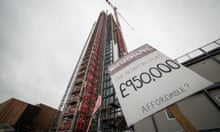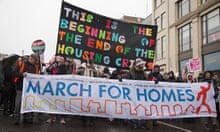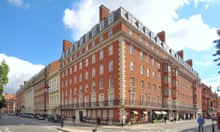To most residents of Abbey Wood in south-east London the prospect of owning one of the flats in the new Abbey Tower development taking shape on their doorstep is as remote as the Hong Kong hotel where they were being sold to investors last weekend.
The luxury apartments are on sale in the UK, too, but with one-bedroom flats starting at £275,000 and those with three bedrooms from £528,000, they are out of reach to many in an area where the average household income is less than £35,000.
“I would love to buy an apartment but I can’t compete with them,” says Aua Yeboah, who works at the Station Studio beauty salon in the shadow of the tower. “We need to move further out of town into Kent to afford to buy. The homes should be for local people.”
Paul, waiting for a bus on the busy flyover which sweeps past the Cross Quarter project, says he would love to buy one if he had the money. He is renting nearby and says his zero-hours contract means he has zero chance of buying. “You don’t know if they will need you, you don’t know how much you will get,” he says.
An early version of the Hong Kong sales poster for Abbey Tower caused a furore for boasting to would-be investors that there would be no social housing in the building. There will be 23 affordable homes on the Cross Quarter site, 23 (11%) of the 216 homes being created.
The figure has been accepted by Greenwich council planners, although it is below the 36 initially proposed and the council’s 35% target.
Giving permission, the council acknowledged that the number was “relatively low” but said the lower number had been accepted due to an independent review of the project’s viability and the fact that the surrounding area already has a high proportion of affordable housing.
Bexley and Greenwich, the two councils in whose area the development sits, together have more than 16,000 households on their lists and the need for places to live was underlined on the front of the local Bexley News Shopper this week: “Teen mum sent to Manchester” recounted the tale of a woman sent to live more than 200 miles away because nearer temporary accommodation could not be found.
The council told the paper: “It is proving necessary on occasion for us to use emergency temporary accommodation that is further afield.”
On a wet morning in January, the shiny investment opportunity touted in the sales brochures also feels a long way off. It is unlikely the agents selling the flats in Hong Kong made much of their proximity to a BP garage or DIY store, but both are just across the busy road.
The view of a low-rise suburban skyline broken by several concrete tower blocks and a couple of wind turbines probably was not what investors were imagining when they invested in a London apartment.
But the first phase of development will bring a big Sainsbury’s and retail space primed to become coffee shops and restaurants, plus a new nursery, public square and public library. And the success of the development seems to hinge on how quickly you will be able to get somewhere else.
Crossrail will arrive in 2018 and the flats are as close as possible to the station. Currently the fastest train to London Bridge takes about 25 minutes and getting to Canary Wharf takes about the same. Transport for London puts the journey time to Oxford Street at 50 minutes.
But, in three years’ time, the journey to Canary Wharf will be cut to 11 minutes and it will take 25 minutes to Bond Street in the West End.
It is this £15bn project that the sellers of apartments in Abbey Towers are playing heavily on. “The arrival of Crossrail in 2018 is a prime example of the growth potential [the developers] look for,” the brochure says. “The superb transport links it will provide to residents will be at the heart of the area’s transformation.”
Jackie Hawkins, lettings manager at the Abbey Wood branch of Hunters estate agents, says Crossrail is driving a lot of new inquiries: “We’ve seen a dramatic increase in demand. It’s changed the way we market things. In the past, if we had a Victorian terrace to sell, we would have a viewing one day and another one the next. Now we have started doing block viewings a bit more,” she says. “It’s really good for the people who live here who are seeing the capital value of their homes increase.”
Hawkins says the area has long attracted investors and this has continued with interest from landlords in London and beyond. A two-bedroom flat currently rents for between £900 and £950 a month, while a three-bedroom terrace can be let for up to £1,300. “The rents haven’t gone up – people aren’t buying here as much for that as for capital growth,” she says. “In future, maybe they will hike the rents up a bit.”
But whether the development will be a catalyst for much growth in the short-term seems unimportant. Earlier this month, property firm JLL described Abbey Wood as a “longer-term, but more opportunistic” bet for developers looking to capitalise on Crossrail. In a report on the potential impact of the project on different neighbourhoods across London, it said it was among several destinations which could offer return safter 2021 but “inevitably carry greater risk” than some of the other areas that will be served by the new link.
The author and JLL’s residential research director, Neil Chegwidden, said the area could attract young professionals drawn by the short commute to Canary Wharf and the City combined with relatively low house prices, but it needed a master plan alongside the current developments to make it more attractive.
“The road network doesn’t really allow for significant development,” he said. “Perhaps in 10 to 15 years, the whole area might have developed but it just hasn’t got critical mass at the moment.”
Some city centre workers buy here, says Hawkins, but also a lot of people who work locally.
Paul says he was attracted by the bus links, while Hawkins says affordability is an attraction. Even though prices are up year-on-year, they are still cheap in London terms: former council houses are being advertised for about £250,000, while Victorian terraces can go for £300,000.
Hawkins says local people are supportive of the development and the new Sainsbury’s is good news for the area. “It’s something Abbey Wood has needed for a long time. There’s no major supermarket or bank or building society in Abbey Wood,” she says.
But one local trader, who asked not to be named, does not think it is right that homes are being marketed abroad. “This is meant to encourage growth for people round here, not investors in other countries,” she says. “There’s a lack of council housing around here and they should be doing something about that.”









Comments (…)
Sign in or create your Guardian account to join the discussion